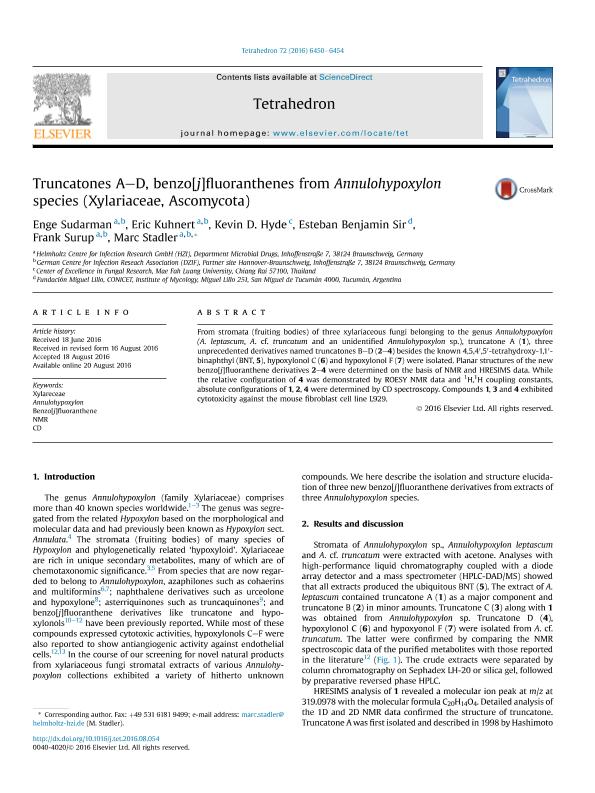Mostrar el registro sencillo del ítem
dc.contributor.author
Sudarman, Enge
dc.contributor.author
Kuhnert, Eric
dc.contributor.author
Hyde, Kevi D.
dc.contributor.author
Sir, Esteban Benjamin

dc.contributor.author
Surup, Frank
dc.contributor.author
Stadler, Marc
dc.date.available
2018-09-06T22:07:35Z
dc.date.issued
2016-10
dc.identifier.citation
Sudarman, Enge; Kuhnert, Eric; Hyde, Kevi D.; Sir, Esteban Benjamin; Surup, Frank; et al.; Truncatones A–D, benzo[j]fluoranthenes from Annulohypoxylon species (Xylariaceae, Ascomycota); Pergamon-Elsevier Science Ltd; Tetrahedron; 72; 41; 10-2016; 6450-6454
dc.identifier.issn
0040-4020
dc.identifier.uri
http://hdl.handle.net/11336/58657
dc.description.abstract
From stromata (fruiting bodies) of three xylariaceous fungi belonging to the genus Annulohypoxylon (A. leptascum, A. cf. truncatum and an unidentified Annulohypoxylon sp.), truncatone A (1), three unprecedented derivatives named truncatones B–D (2–4) besides the known 4,5,4′,5′-tetrahydroxy-1,1′-binaphthyl (BNT, 5), hypoxylonol C (6) and hypoxylonol F (7) were isolated. Planar structures of the new benzo[j]fluoranthene derivatives 2–4 were determined on the basis of NMR and HRESIMS data. While the relative configuration of 4 was demonstrated by ROESY NMR data and1H,1H coupling constants, absolute configurations of 1, 2, 4 were determined by CD spectroscopy. Compounds 1, 3 and 4 exhibited cytotoxicity against the mouse fibroblast cell line L929.
dc.format
application/pdf
dc.language.iso
eng
dc.publisher
Pergamon-Elsevier Science Ltd

dc.rights
info:eu-repo/semantics/openAccess
dc.rights.uri
https://creativecommons.org/licenses/by-nc-sa/2.5/ar/
dc.subject
Annulohypoxylon
dc.subject
Benzo[J]Fluoranthene
dc.subject
Cd
dc.subject
Nmr
dc.subject
Xylareceae
dc.subject.classification
Otras Ciencias Químicas

dc.subject.classification
Ciencias Químicas

dc.subject.classification
CIENCIAS NATURALES Y EXACTAS

dc.title
Truncatones A–D, benzo[j]fluoranthenes from Annulohypoxylon species (Xylariaceae, Ascomycota)
dc.type
info:eu-repo/semantics/article
dc.type
info:ar-repo/semantics/artículo
dc.type
info:eu-repo/semantics/publishedVersion
dc.date.updated
2018-09-04T16:35:40Z
dc.journal.volume
72
dc.journal.number
41
dc.journal.pagination
6450-6454
dc.journal.pais
Estados Unidos

dc.journal.ciudad
Nueva York
dc.description.fil
Fil: Sudarman, Enge. Helmoholtz Centre for Infection Research; Alemania
dc.description.fil
Fil: Kuhnert, Eric. Helmoholtz Centre for Infection Research; Alemania
dc.description.fil
Fil: Hyde, Kevi D.. Mae Fah Luang University; Tailandia
dc.description.fil
Fil: Sir, Esteban Benjamin. Consejo Nacional de Investigaciones Científicas y Técnicas. Centro Científico Tecnológico Conicet - Tucumán; Argentina. Fundación Miguel Lillo; Argentina
dc.description.fil
Fil: Surup, Frank. Helmholtz Centre for Infection Research ; Alemania
dc.description.fil
Fil: Stadler, Marc. Helmholtz Centre for Infection Research ; Alemania
dc.journal.title
Tetrahedron

dc.relation.alternativeid
info:eu-repo/semantics/altIdentifier/doi/https://dx.doi.org/10.1016/j.tet.2016.08.054
dc.relation.alternativeid
info:eu-repo/semantics/altIdentifier/url/https://www.sciencedirect.com/science/article/pii/S0040402016308304
Archivos asociados
